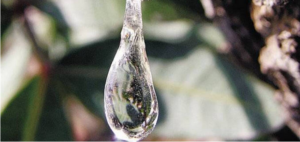When the sun sets, the grandmothers of Mastichochoria, the 24 mastic-producing villages of southern Chios, sit in plastic chairs outside their stone houses, watching everyone who comes and goes. As a boy who spent his summers on the island, my partner Andreas was always afraid of them. Dressed all in black, these wizened women guard their streets like sphinxes, detaining children and foreigners with their endless questions: “Who are you? What are you doing here? Where are you from? Who are your parents?”
Two of these curious old women apprehended me one evening while I was waiting to meet a friend, and after the usual, well-intentioned interrogation, they asked if I knew the story of Agios Isidoros, patron saint of the mastic tree (Pistacia lentiscus var. chia, or schínos in Greek). Isidoros served as a Roman naval officer on Chios around 250 CE. After confessing his Christian faith to Admiral Numerius, he was tortured and beheaded before a schínos tree, which received its share of blows. Legend has it that the saint’s martyrdom caused the tree’s wounds to weep, yielding the first mastic “tears.” Though the tree grows throughout the Mediterranean, it produces this thick, aromatic resin, the “miracle” of Agios Isidoros, only in southern Chios.
God’s timing is perfect, even when things seem to go wildly wrong, says Washington pastor
The exact reason for this site specificity is unknown, but scientists attribute it to three factors: first, a unique microclimate characterized by mild winters and hot, arid summers allows mastic tears to dry on contact with air; second, centuries of selective propagation privileged trees that created the most and best quality resin; third, organized commercial exploitation since the Middle Ages—and especially during Genoese rule in the 14th century—standardized the product and established wide demand for it as a luxury item.
Continue here: ICWA
Ask me anything
Explore related questions





